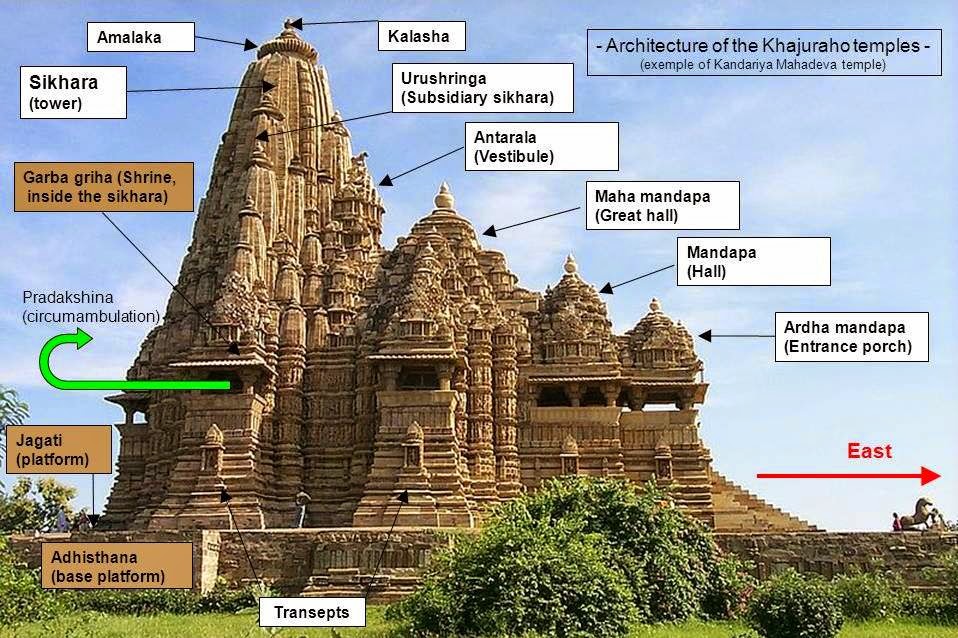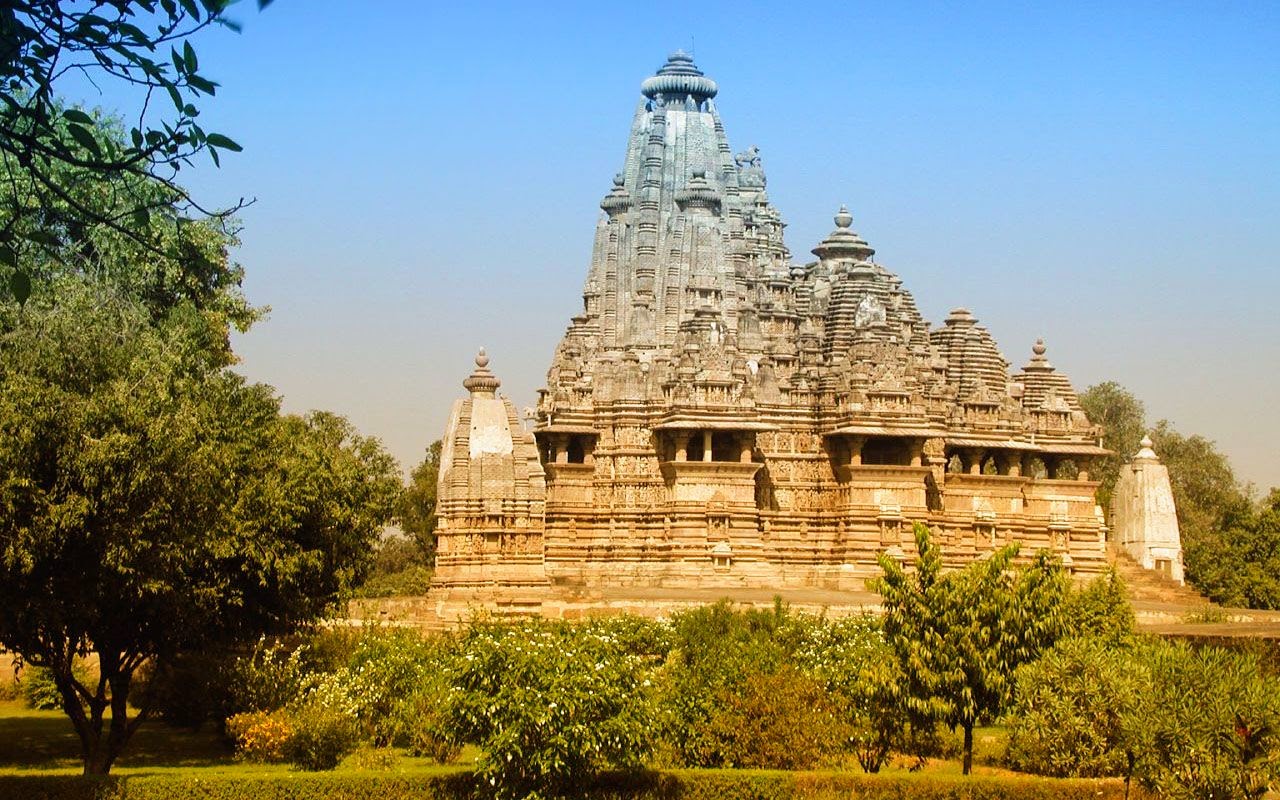Khajuraho (Hindi: खजुराहो) is a village in the Indian state of Madhya Pradesh, located in Chhatarpur District, about 385 miles (620 kilometres) southeast of Delhi, the capital city of India.
The Khajuraho group of monuments has been listed as a UNESCO World Heritage Site.
One of the most popular tourist destinations in India, Khajuraho has the largest group of medieval Hindu and Jain temples, famous for their erotic sculpture. The name Khajuraho, ancient "Kharjuravahaka", is derived from the Sanskrit word kharjur meaning date palm.
The art of Madhya Pradesh at once brings in to mind the exuberant art and the creativity immortalized in the figurative molds in the temples of Khajuraho. Viswanatha Temple The temples of Khajuraho are one of India’s major attractions. Once a great Chandella capital, Khajuraho is now a quiet village of over 6000 people. The temples are superb examples of Indo-Aryan architecture, but it’s the decorations with which they are so liberally embellished, that have made Khajuraho famous.
Around the temples are bands of exceedingly fine and artistically carved stonework. There are sculptors, which have shown many aspects of Indian life, 1000 years ago - gods and goddesses, warriors and musicians, real and mythological animals. These temples were built by the Chandellas, a dynasty that survived for five centuries before falling to the onslaught of Islam. Almost all Khajuraho’s temples record a century long burst of creative genius from 950- 1050 A.D.
Basically all the temples follow a three-part layout. You enter the temple through a porch, known as the Ardhamandapa. Behind this is the hall or Mahamandapa, supported with pillars and with a corridor around it. A vestibule then leads into the Garbhagriha, the inner sanctum, where the image of the god to which the temple is dedicated is displayed.
The temples are almost all aligned east to west, with the entrance facing east. Some of the earliest temples were made of granite, or granite and sandstone but all the ones from the classic period of Khajuraho's history are made completely of sandstone.
The whole area was enclosed by a wall with eight gates, each flanked by two golden palm trees. There were originally over 80 Hindu temples, of which only 25 now stand in a reasonable state of preservation, scattered over an area of about 8 square miles (21 km²). The temples of Khajuraho suffered destruction by early Muslim invaders between c.1100-1400 AD as various disfigured statues at the temple complex attest.
Today, the temples serve as fine examples of Indian architectural styles that have gained popularity due to their explicit depiction of the traditional way of sexual life during medieval times.
Locals living in the Khajuraho village always knew about and kept up the temples as best as they could. They were pointed out to an English man in late 19th century and the jungles had taken a toll on all of the monuments.
 |
Architecture of the Khajuraho temples |
The Khajuraho temples, constructed with spiral superstructures, adhere to a northern Indian shikhara temple style and often to a Panchayatana plan or layout. A few of the temples are dedicated to the Jain pantheon and the rest to Hindu deities - to God's Trio, Brahma, Vishnu and Shiva, and various Devi forms, such as the Devi Jagadambi temple.
A Panchayatana temple had four subordinate shrines on four corners and the main shrine in the center of the podium, which comprises their base. The temples are grouped into three geographical divisions: western, eastern and southern.
With a graded rise secondary shikharas (spires) cluster to create an appropriate base for the main shikhara over the sanctum. Kandariya Mahadeva, one of the most accomplished temples of the Western group, comprises eighty-four shikharas, the main being 116 feet from the ground level.
The Khajuraho temples are made of sandstone, they didn't use mortar the stones were put together with mortise and tenon joints and they were held in place by gravity. This form of construction requires very precise joints. The columns and architraves were built with megaliths that weighed up to 20 tons.
These shikharas – subordinate and main – attribute to the Khajuraho temples their unique splendor and special character. With a graded rise of these shikharas from over the ardhamandapa, porch, to mandapa, assembly hall, mahamandapa, principal assembly hall, antarala, vestibule, and garbhagriha, sanctum sanctorum, the Khajuraho temples attain the form and glory of gradually rising Himalayan peaks.
The name Khajuraho, or Kharjuravāhaka, is derived from ancient Sanskrit (kharjura, खर्जूर means date palm, and vāhaka, वाहक means "one who carries" or bearer). Local legends state that the temples had two golden date-palm trees as their gate (missing when they were rediscovered).
Khajuraho is one of the four holy sites linked to deity Shiva (the other three are Kedamath, Kashi and Gaya). Its origin and design is a subject of scholarly studies. Shobita Punja has proposed that the temple’s origin reflect the Hindu mythology in which Khajuraho is the place where Shiva got married; with Raghuvamsha verse 5.53, Matangeshvara honoring ‘’Matanga’’, or god of love.
These temples of Khajuraho have sculptures that look very realistic and are studied even today.
'Kamasutra' Endless at Khajuraho
The Khajuraho temples do not contain sexual or erotic
art inside the temple or near the deities; however, some external carvings bear
erotic art. Also, some of the temples that have two layers of walls have small
erotic carvings on the outside of the inner wall. There are many
interpretations of the erotic carvings. They portray that, for seeing the
deity, one must leave his or her sexual desires outside the temple. They also
show that divinity, such as the deities of the temples, is pure like the atman,
which is not affected by sexual desires and other characteristics of the
physical body.
It has been suggested that these suggest tantric sexual practices. Meanwhile, the external curvature and carvings of the temples depict humans, human bodies, and the changes that occur in human bodies, as well as facts of life. Some 10% of the carvings contain sexual themes; those reportedly do not show deities, they show sexual activities between people. The rest depict the everyday life of the common Indian of the time when the carvings were made, and of various activities of other beings. A common misconception is that, since the old structures with carvings in Khajuraho are temples, the carvings depict sex between deities.
However the kama arts represent diverse sexual expressions of different human beings. The vast majority of arts depict various aspects the everyday life, mythical stories as well as symbolic display of various secular and spiritual values important in Hindu tradition. For example, depictions show women putting on makeup, musicians making music, potters, farmers, and other folks in their daily life during the medieval era. These scenes are in the outer padas as is typical in Hindu temples.
It has been suggested that these suggest tantric sexual practices. Meanwhile, the external curvature and carvings of the temples depict humans, human bodies, and the changes that occur in human bodies, as well as facts of life. Some 10% of the carvings contain sexual themes; those reportedly do not show deities, they show sexual activities between people. The rest depict the everyday life of the common Indian of the time when the carvings were made, and of various activities of other beings. A common misconception is that, since the old structures with carvings in Khajuraho are temples, the carvings depict sex between deities.
However the kama arts represent diverse sexual expressions of different human beings. The vast majority of arts depict various aspects the everyday life, mythical stories as well as symbolic display of various secular and spiritual values important in Hindu tradition. For example, depictions show women putting on makeup, musicians making music, potters, farmers, and other folks in their daily life during the medieval era. These scenes are in the outer padas as is typical in Hindu temples.
*NOTE: SOME OF THE SCULPTED IMAGES ON THIS PAGE ARE EROTIC IN NATURE
 |
| A view on the famous temples |
 |
| Between the skies and bushes |
 |
| A closer look at a temple in Khajuraho |
 |
| Adinath Temple |
 |
| Adinath_Jain_Temple_Khajuraho_12 |
 |
| Admiring Khajuraho...The lady Brigade |
